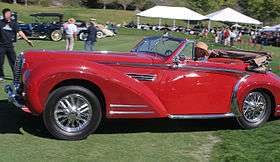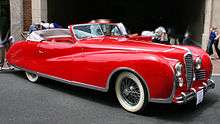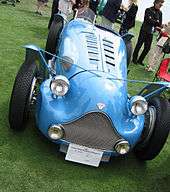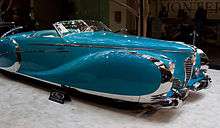Delahaye 175
The Delahaye 175 is an automobile manufactured by Delahaye between 1947 and 1951. The last of the large Delahayes, the type 175 was essentially a brand new chassis and engine. The chassis bore little resemblance to the preceding Type 135, other than in the cockpit area, with its welded driveshaft tunnel and perimeter-welded stamped-steel floor that acted as a stressed structural member. It introduced the semi-monocoque chassis structure to the automobile realm. This revolutionary approach allowed the seat rails to be mounted on the bottom-plane of the chassis, instead of sitting on top of it, as competitors were doing. Their chassis had a heavy X-braced cruciform in the middle of the passenger compartment, with the driveshaft passing through a hole at intersection.. This methodology allowed a Coachbuilt Delahaye body to be lower in profile than the competition. The rigid chassis delighted France's coachbuilders for its remarkable rigidity, low profile stance, and its comfortably expansive completely rectangular passenger compartment.
| Delahaye 175/178/180 | |
|---|---|
 1947 Delahaye 175 (Henri Chapron) | |
| Overview | |
| Manufacturer | Delahaye |
| Production | 1948–1951 |
| Body and chassis | |
| Class | Luxury car |
| Layout | FR layout |
| Related | Delahaye 135 |
| Powertrain | |
| Engine | 4,455 cc type 183 I6 |
| Transmission | 4-speed pre-selector (Cotal) |
The new 4.5-litre engine was an overhead-valve inline six, visually similar to the preceding Type 135, but significantly larger, and substantially improved. It had seven main bearings, versus the Type 135's four, and its cylinder head had six intake and six exhaust ports, twelve in all, versus nine in the standard Type 135 (albeit a rare few Type 135 racing-engines had twelve port heads). The new liter larger engine was stronger, likely no heavier, and had improved breathing. Unlike the cast-iron cylinder block of previous models, the new 4.5-liter six-cylinder engine had a cast aluminum block and a cast-iron cylinder head. Separating these disparate metals was a copper-and-asbestos-sandwiched head-gasket. The compression ratio was a modest 6.5:1, but was modestly increased in the performance enhanced optional Type 175S variant. These latter were equipped with three downdraught Solex AIP carburetors, instead of one; and, chrome, center-locked Rudge wire-laced wheels on splined hubs, instead of the ubiquitous bolted-on stamped steel variety seen on the majority of Delahaye cars as well as those from its competitors that included Citroen, Peugeot, Talbot and some others. There were very few manufacturers of wheels, especially wire-spoked ones, those being limited to Rudge and its licensee Boranni, in Italy.
Notably: Delahaye did not differentiate which of its Type 175 chassis was a standard version, or an optional 175S, in its recorded production build numbers.
Of further note: Delahaye offered the "S" option exclusively on its performance enhanced Type 175S model. However: there are known examples of Type 178 that were originally built with one or both factory options (ie: the Petersen Museum's Chapron-bodied Type 178 cabriolet, production build number 820034, has triple Solex carburetors, and chromed Rudge wire wheels; and, the 4.5-liter six-cylinder experimental prototype chassis that was originally referred to by involved factory workers as "92002", that was originally fitted with three downdraught carburetors, but stamped-steel wheels; and both of the Type 180 armoured limousines built by Henri Chapron for the executives of the French Communist party had triple Solex carburetors, as were needed due to the greatly increased vehicle weight. There may be other examples of Delahaye's legendary inconsistency. The foregoing above prototypical unit was eventually liquidated, and to do so, had its chassis and engine stamped as being the first Type 178, recorded as production build number 820001.. Both it and the Petersen Museum's car have the early Type 1AL engine, yet the prototype dates back to before early 1946, while the Petersen 178 was built toward the cessation of production in 1951. There is no record of how many early Type-1AL-series engines were made, but there are at least ten known examples that exist.
By 1946, those familiar with the workings of Delahaye, knew of the existence of six pre-production chassis-units. The six included the original developmental wheeled experiment; and, the 1946 to 1949 Paris Auto Salon show-chassis. The latter could not be confused with any of the other five, due to its glitzy presentation finish in glossy white paint accented by its chromed and polished aluminum features, resting sedately on chromed wire wheels fitted with Dunlop white-sidewall tires. These initial six units were: 90001; 91001; 91002; 92001; 92002 and the un-numbered show-chassis. The intentionally confusing numerical sequence was managing director Charles Weiffenbach's strategy to intentionally obfuscate the prototype's identity, so that it could be surreptitiously liquidated with nobody the wiser, instead of being scrapped, as was normal procedure, in order to recover a portion of the new chassis-series' development costs. It was a devious plan that worked. No record ever existed, and Monsieur Charles took this secret to his grave, in 1958, about four years after Delahaye closed and locked its doors on December 31st, 1954, for the last time.
The new chassis introduced the modern and evolving semi-monocoque concept, for the first time. The chassis was completely different from the foregoing Type 135 in dimensions, proportions, and its structural design. The sole commonality was a stressed steel floor-pan, which in the new chassis was dramatically larger, with parallel instead of the Type 135's tapering outer rails. The Type 135 chassis, at its widest point, was approximately 10 centimeters narrower than the new design. Importantly: Jean Francois had introduced the stressed steel floor in his earlier Type 135 chassis. He expanded greatly on the proven structural technique that effectively stiffened and reinforced the chassis-structure, eliminating flexing and torsional twist, delighting the coachbuilders. A distinct feature of the new chassis was the nearly round open hoop through both rear chassis-rails, through which the DeDion tube and the splined differential half-shafts extended out to the hub-carriers that were bolted onto conventional semi-elliptical leaf springs. The rear of the chassis, aft of the cockpit, was very similar to the Bugatti Type 57.
More modern suspension than that of the Type 135 was featured in the 175/178/180 chassis-series. Delahaye's Type 135 had independent front suspension, a proprietary system it shared with Delage and Talbot-Lago. The new 4.5-liter chassis had a previously untried independent front suspension that was unfamiliar to Delahaye. This was the proven Dubonnet-licensed independent suspension system replacing the outdated proprietary system used in the Delahaye Types 135, 145, 155, and 165. The Dubonnet system was not unproven, since it was adopted by General Motors in 1933, as well as by Alfa-Romeo, and Vauxhall. Time proved the Dubonnet system to be problematical, unless it was fastidiously serviced and rigorously maintained. Oil-seal leaks caused component seizures, and notorious internal component breakage.
The new chassis's rear DeDion suspension system had earlier been employed by Delahaye, in its infamous Type 155 grand-prix (single-seat) "monoposto". Like the Type 155, the Type 175, 178, and 180 DeDion system featured a rigidly mounted differential in a cast aluminum housing containing a Gleason hypoid final-drive gear-set, with a curve-formed large-diameter steel tube connecting both rear hubs. The rear wheels were driven by splined half-shafts. The semi-elliptical rear leaf-springs were conventional, and dampened by lever-arm hydraulic shock absorbers, instead of outdated friction-type. The new inline six-cylinder overhead-valve engine produced between 140 and 160 brake horsepower, depending on whether a single Solex carburetor, or triple Solex carburettors were fitted. The standard compression ratio was a modest 6.8:1. The optional Type 175-S had an increased compression ratio, for enhanced performance.
The Type 175-S racing engines employed by Charles Pozzi, and France's champion driver, Eugene Chabaud, had a claimed 9.1:1 compression ratio, and with its three horizontal Stromberg carburetors, was claimed to deliver over 220 brake horsepower. The higher performance Type 175S came with two factory options: Rudge wire-wheels; and, three Solex down-draft carburetors. The front's new grille designed by young in-house designer, Philippe Charbonneaux, in a corporate effort to develop a particular Delahaye "face" after the war. Delahaye required coachbuilders to use the new corporate grille design, although several of the more famous, such as Joseph Figoni (of Figoni et Falaschi), Jacques Saoutchik, and Henri Chapron were given artistic licence.
The new six-cylinder 4.5-litre engine in these cars carried the "183" casting-code, and were made in two visually distinct forms. The initial series engines were stamped: Type 1AL-183, as were found in all six pre-production units known about in 1946; and, the two Type 175S racing engines that Delahaye loaned to Charles Pozzi and his Ecurie Lutetia co-owning team-mate, Eugene Chabaud. But, the majority of the production motors were stamped as being Type 2AL-183. These came out of the same "183" casting molds, but were of revised configuration, with modifications made for easier production, cost efficiencies, and allegedly for internal reinforcement of the bottom end. The only transmission offered was the semi-automatic, electrically shifted, solenoid-actuated, four-speed epicyclic gearbox by Cotal. The shift lever protruding from the transmission operated forward and reverse only. These cars could be driven in either direction, with the same four gear-ratios. Attempting go go as fast backwards was only for the brave or fool-hardy, as was demonstrated by racing-team owner Rob Walker in his grand-prix Delage, to his chagrin.
— 'Autocar' magazine article
HISTORY
After having spent much of the Second World War building railroad rolling stock (train cars) for the German occupiers, Delahaye was included in deputy director General Paul-Marie Pons' 1945 plan Pons for French industry and engineering. His Plan Pons was a five-year program for the reconstruction of French industry, and a supposed source for incoming capital for French companies and the government's depleted coffers. The plan allotted Delahaye the position of building covetable sports and luxury cars for the export market. Over 80 percent of the company's automobile chassis were exported to France's colonies, including those in Africa. The objective was to generate much-needed foreign currency for France's struggling postwar economy. The outdated prewar Types 134, 135, and 148L were revived, but Delahaye still needed a "halo car" like the 165. In consideration of the inordinate expense of producing the complicated V-12, with its exotic alloys, as used in the Type 145 sports-racers, the solitary Type 155 monoposto (all five were made exclusively for Lucy O'Reilly Schell for her team Écurie Bleue), as well as in the four luxurious and impressive Type 165 grand-touring cars, production of the V-12 ended in 1938, with just twelve sets of engine parts made. The excessively complex V12 had three camshafts in the block; four overhead rocker-shafts; twenty-four each of pushrods, cam followers, and rocker-arms; three Stromberg carburetors (in the Types 145 and 155, but a single one in the detuned Type 165); two mechanical fuel-pumps, dual Bosch ignition.[1]
The V-12 was replaced by a new, much less complex inline overhead-valve six-cylinder of the same displacement.[2] The new Type 175 debuted as a glitzy show-chassis with partial front coachwork demonstrated the company's new postwar "face". It was one of very few totally new machines to debut at the first postwar Paris Salon in October 1946. It garnered considerable attention. It would also be Delahaye's first left-hand drive model.[3]
The chassis however, was not yet fully developed (in October 1946), nor adequately performance tested, before being put into production. Problems were encountered with the Dubonnet front suspension, and sheared rear half-shafts, due to the hefty postwar enveloping-style bodies with hardwood body-frames under them, contributing excessive weight for the chassis' prewar engineering. The same unchanged Show-chassis reappeared on Delahaye's stand in 1947, again in 1948, and finally in 1949, with somewhat more but still limited frontal coachwork. There was nothing whatsoever aft of the instrument panel on the cowl-scuttle. Production did not truly begin until early 1948. Some say, with reasoned conviction, that this chassis-series was never fully developed. The extended delay was due to Jean Francois' unanticipated death in April 1944, from a terminally diagnosed chest disorder (likely tuberculosis or lung-cancer). There was nobody qualified at Delahaye to take his place. However, as most of the French grandes marques no longer existed after the war, the coachbuilders descended upon the Type 175S, in particular, to prove their art.[4]


The company's Production Build List verifies that 51 Type 175 chassis were built (numbers 815001 to 815051 inclusive), but that excludes the Paris Type 175S Show-chassis. With it included as it ought to be, since it in fact existed, the Type 175/175S total perhaps comes to 52 in all, although there is reason to believe it was dismantled in late 1949, for its chassis and pertinent mechanical parts to be recycled into the final few chassis in this series. Nobody knows with certainty, and the show-chassis never appeared again in any recognizable form, either in whole or in part.[5][6] with no differentiation explaining which of these were Type 175 or optional 175-S chassis. While not a grand success in the marketplace, a Type 175S won the 1951 Monte Carlo Rally,[7] the same car finished in twelfth place in the Carrera Panamericana, while a second Motto-bodied 175S coupe was disqualified on a technicality.<DELAHAYE Sport et Prestige by Francois Jolly)[8] The optional 175S came with three carburettors and like the 175, had a short 2.95-metre wheelbase; two longer wheelbased versions with single carburetors and 140 HP were also built: The Production Build List confirms there were 38 of the 3.15-metre wheelbase Type 178 built; and, 18 Type 180 chassis [2] and 180 (333.5 cm) were produced, mainly for heads of state, dignitaries, and the like. Two Henri Chapron-bodied, fully armoured 180 limousines were built for the leadership of the French Communist Party in 1948.[5] A prototype "Delage D180" was also developed on this basis, but never entered production as Delahaye focused its Delage production on their D6 model.[8] Production of three-chassis series, including the prototype and the show-chassis, was 107 total units. (substantiated by Club Delahaye president Jean-Paul Tissot, from archived company records) [8]

.jpg)
The Type 1AL-183 and Type 2AL-183 engines, when equipped with a single carburetor, produced 140 horsepower, allowing a top speed of 130 km/h (type 180), 140 km/h (type 178) and 145 km/h (type 175). The triple-carbureted 175S raised this to about 160 km/h (99 mph), although naturally these figures were subject to variation depending on which sort of body was fitted, and which coachbuilder made it. Coachbuilder Jacques Saoutchik seemed oblivious of weight, and employed flamboyant heavily chromed brass embellishments on his extended, enclosed fendered bodies.
The rear-wheel drive Type 175, 178 and 180 chassis is considerably more sophisticated than its 135 predecessor, the front suspension being independent with pivoting horizontal cylinders that contained a powerful coil-spring and hydraulic shock absorber in an oil-bath Dubonnet. The rear was by de Dion, with semi-elliptical springs. Brakes were hydraulic type made by Lockheed. The brake-drums were of deeply finned cast-iron, actuated by dual master cylinders with a balance-bar.[8]
The custom bodies of these cars were often much too heavy for what the chassis had originally been engineered for, leading to collapsing Dubonnet suspension, and sheared differential half-shafts. In dry conditions, these were fast cars, but Wet-weather handling was considered unpredictable. A shortage of time and money for development may have been a cause of the 175's failure.[2] Delahaye's reputation for solidity took a serious hit in consequence. The real culprit, however was inferior postwar steel quality, following the war. The engineer's specified grade had been completely consumed by the war, and what little could be gotten came through the French government, and it had not prioritized luxury car-makers. Due to buyer resistance, France's exhorbitant luxury tax on non-essentials, and the ever diminishing sales volume, the Types 175, 178 and 180 ceased production in 1951. Although Delahaye managed to introduce the seemingly more modern 235 in 1951, this was just an updated variation of the Type 135, equipped with three Solex carburetors and hydraulic brakes. It was too little, too late, to make a difference, despite being an excellent automobile. The company did not survive much longer. Its doors were permanently closed and locked on December 31st, 1954. Sixty years of car production had come to an ignominious end in defeat. Delahaye amalgamated with, but was actually absorbed by arch-competitor Hotchkiss, in 1953. Both Delahaye and Hotchkiss succumbed to the reality of changing global circumstances, causing their absorption by the giant Brandt organization, for their assets to be converted into making other industrial and commercial items, including household appliances. The Delahaye automobile, and its captured Delage marque were relegated to history.[9] Delahaye and Delage combined production dropped from 511 in 1949, to 41 in 1952; 36 in 1953; and 7 in 1954.[2]
Bibliography
- Hull, Peter. Delahaye: Famous on Road and Race Track, in Ward, Ian. World of Automobiles, Volume 5, pp. 521–524. London: Orbis, 1974.
References
- Hull, p. 524.
- Le Roux, André. "Delahaye 180" (in French). Carcatalog. Archived from the original on 2011-07-20. Retrieved 2010-10-19.
- Hull, p. 524.
- Phedor. "Les Delahaye 175-178-180 (1946-51): le destin d'une reine éphémère..." [The Delahaye 175-178-180 (1946-51): The fate of an ephemeral sovereign] (in French). Club Doctissimo. Retrieved 2010-10-19.
- "Delahaye 180 (Lot 14 / Sale 5001)". Christie's. Retrieved 2010-10-18.
- "BBC News - Diana Dors sports car to be sold". Bbc.co.uk. 2010-08-15. Retrieved 2010-08-14.
- Hull, Peter. "Delahaye: Famous on Road and Race Track", in Ward, Ian, executive editor. World of Automobiles (London: Orbis, 1974), Volume 5, p. 524.
- Rousseau, Jacques; Caron, Jean-Paul (1988). "134". Guide de l'Automobile Française. Paris: Solar. ISBN 2-263-01105-6.
- Club Delahaye journal; auto-historians Andre Vaucourt, Jacques Dorizon and Phillippe Bavouzet, Jean-Pierre Bernard; Jean-Paul Tissot; and, Brian Arthur Johnston; Adatto, Richard S; Meredith, Diana E. (2006). Delahaye Styling and Design. Deerfield, IL: Dalton Watson Fine Books. ISBN 978-1-85443-221-6.